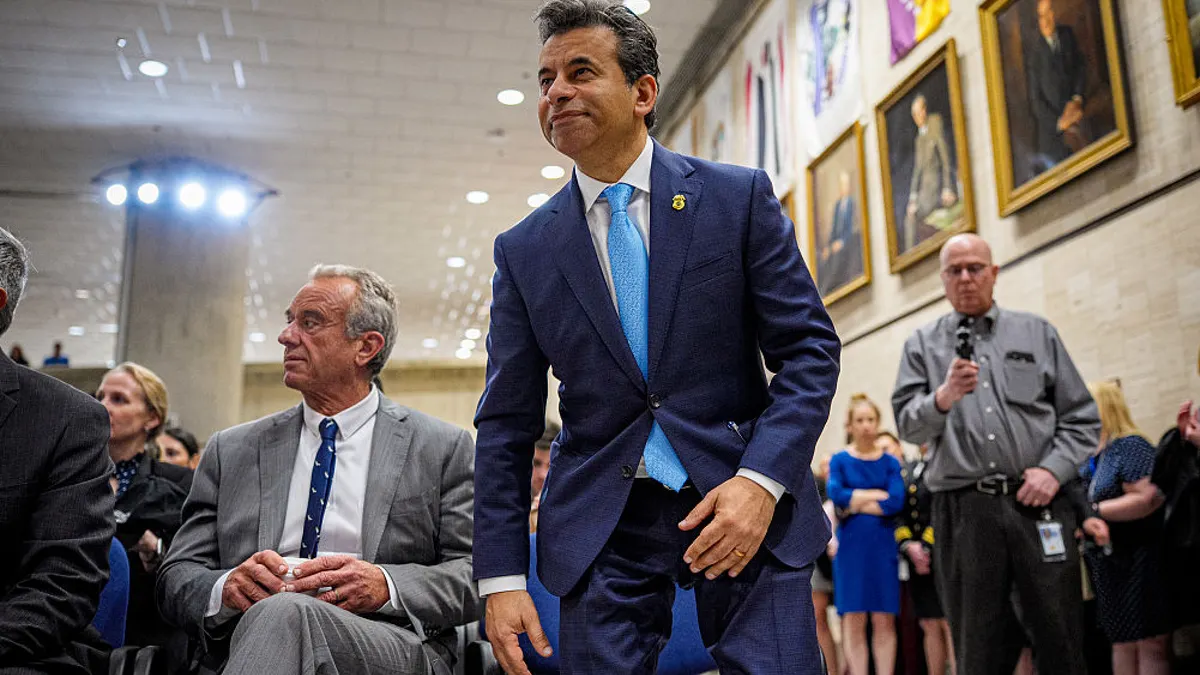Job cuts were just the first disruption at health agencies. Now, questions remain about how the FDA will be reshaped after commissioner Dr. Marty Makary “rejected” a proposed restructuring that was leaked this month.
The proposal would have upended the agency’s organizational structure and created five new shared services offices rather than current product-based offices. But Makary shot down some of those rumors about the scale of the reorganization.
“There will not be a reorganization,” Makary said yesterday in an interview with MedPage Today. “Yes, we are consolidating travel offices, IT and some other things that make sense for efficiency, but nothing else is planned. A proposal for a reorganization came from some staff, but I rejected that proposal. I said that we will work within the existing structure.”
But without any official reordering plan from the administration, Makary’s latest comments add to the uncertainty of an already frayed situation.
The health agencies are already hurting after a massive workforce reduction announced in April slashed 10,000 jobs across HHS, including 3,500 at the FDA, and has already impacted the flow of agency work. The overhaul was part of HHS’ stated effort to save $1.8 billion per year and “streamline” agency divisions from 28 to 15, it announced in March.
Some pharma and biotech companies have experienced delays in the aftermath, with the FDA pushing back decisions on clinical trials, hearings and drug approvals.
The Trump administration was targeting fiscal year 2026, which begins in October, to implement the proposed FDA restructuring plan, according to AgencyIQ. And while Makary’s latest comments may have quelled some fears, the leaked plan piled onto mounting concerns about other top-down changes. At any scale, the reorganization of the agency is likely to have a long-term impact.
“This would be a radical and profound change,” Laura DiAngelo, senior director of research at AgencyIQ, said during a recent webinar on the restructuring. “It takes a long time to understand where everyone sits, who everyone is reporting to, what everyone's workstreams look like when under a new reporting system.”
Shared services
One of the biggest changes in the proposed structure brought all product review divisions into one. The FDA underwent the “single largest reorganization in the agency’s recent history” last year, mostly on the human foods side. During this reordering, the FDA brought reviews and inspections under one office, according to Alec Gaffney, executive director, regulatory policy and intelligence at AgencyIQ.
The new plan aimed to once again separate those offices, potentially undoing any efficiencies gained when the FDA made changes last year based on the recommendations from an independent expert panel.
“The entire reorganization of the human foods program … was done purely because they [said] we need inspectors and reviewers in the same office so that they can talk to each other, because it doesn’t make sense to split that up,” Gaffney said.
According to Dr. Peter Lurie, former associate commissioner for public health strategy and analysis at the FDA, such a separation would have had unintended consequences that undermine “the current system designed to protect reviewers from the kinds of political interference that can damage public health.” It would also “unravel years” of agency effort to solve problems more effectively and “reverse and destroy current alignment around products,” he said in a statement.
Even if Makary hadn’t shot the plan down, Congress could object to the restructuring efforts.
“It would not surprise me if Congress takes a look at this and goes, we actually know a lot about why this would not be a good idea because we just reorganized stuff based on the fact that this approach … that’s being raised here is a bad idea, specifically with reviews and inspections being in separate offices,” Gaffney said.
The proposal to create five offices also took some heat from former FDA officials, including Janet Woodcock, a long-time FDA leader, who called the idea “a mindless approach” and slammed the attempt at centralization, Pink Sheet reported.
But the biggest impact to the FDA’s operations may be the current workforce reductions combined with a draft budget proposal that would slash nearly 20% of the FDA’s budget as part of a plan to cut one-third of HHS’ coffers overall. What eventually gets approved by Congress for the 2026 fiscal year could look substantially different from the leaked proposal.
Growing pushback
Makary’s comments come after swift backlash to the healthcare agency changes.
Biotech leaders voiced concerns this month in a letter to Senate HELP Committee Commissioner Sen. Bill Cassidy, R-La., and asked the legislative body to understand how the job cuts have impacted critical functions at the FDA. Cassidy and Sen. Bernie Sanders, I-Vt., also asked HHS Secretary Robert F. Kennedy Jr. to testify earlier this month with an update on the FDA reorganization. The hearing didn’t happen, and HHS officials briefed Senate members instead.
Meanwhile, some legal experts have argued that the workforce reduction and how it was executed might be illegal.
Others are sounding the alarm about the lack of HHS communication, despite Kennedy’s stated commitment to “radical transparency.”. Three former FDA leaders, including Lurie, took to The Washington Post to voice worries that Kennedy’s actions are making the agency’s moves more opaque — a shift that started with a freeze on HHS communications after President Donald Trump took office. Staff from the communications departments at the FDA, including those who handle FOIA requests, have also been let go.
“With so much obfuscation and opacity at HHS, it has become crystal clear that ‘radical transparency’ is not about openness and engagement,” they wrote.

















